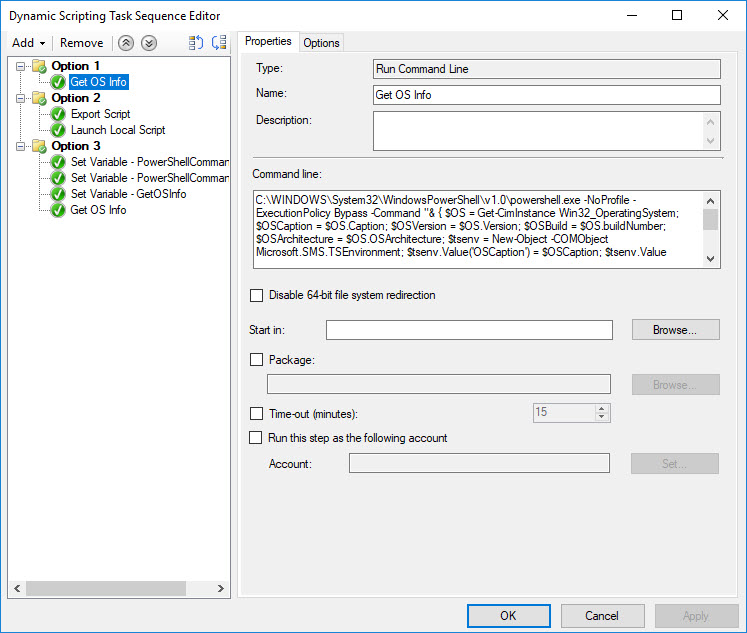
- #POWERSHELL EXECUTE COMMAND LINE EXE HOW TO#
- #POWERSHELL EXECUTE COMMAND LINE EXE INSTALL#
- #POWERSHELL EXECUTE COMMAND LINE EXE UPDATE#
- #POWERSHELL EXECUTE COMMAND LINE EXE SOFTWARE#
- #POWERSHELL EXECUTE COMMAND LINE EXE PC#
Note: For PowerShell Remoting to work in a workgroup environment, you must configure your network as a private, not public, network. RELATED: What's the Difference Between Private and Public Networks in Windows?
#POWERSHELL EXECUTE COMMAND LINE EXE PC#
You should have already enabled Remoting on the PC to which you want to connect, as we described in the previous section. If your computers aren’t on a domain, you need to perform a few more steps to get things set up. They might have good reasons for not allowing the practice, or they might be willing to set it up for you. As always, check with your admins before you try anything like this. You might also not have the permissions you need to run PowerShell as an administrator. Remoting might be disabled-or even enabled-automatically by group policy configured by an admin. Note: Your success in setting up remoting in a domain environment depends entirely on your network’s setup. If your computers are part of a workgroup-which they probably are on a home or small business network-you have a bit more setup work to do. You can skip on ahead to testing your connection. If your PCs are part of a domain, that’s all the setup you have to do. The -Force part of the cmdlet tells PowerShell to perform these actions without prompting you for each step. This command starts the WinRM service, sets it to start automatically with your system, and creates a firewall rule that allows incoming connections. The NPM framework gives access to many different JavaScript solutions, which can be found at the PowerShell window, type the following cmdlet (PowerShell’s name for a command), and then hit Enter: Enable-PSRemoting -Force You’ve also written your first node.js JavaScript program!
#POWERSHELL EXECUTE COMMAND LINE EXE INSTALL#
You should now be able to install both the Node.js framework, and the NPM package manager. You can close this window whenever you are ready. The system will switch back to a command prompt. To turn off the program, switch back to PowerShell and press Ctrl+C. Any other computer that tries to access your system on port 8080 will see the Hello World notice. Right now, your computer is acting like a server. Next, open a web browser, and enter the following into the address bar: In the very upper-left corner, you should see the text Hello World! You may see a Windows Defender notice about allowing traffic – for now, click Allow.Ĥ.

In reality, your script is running in the background. Open the PowerShell, and enter the following: node \users\\myprogram.js Next, copy and paste the following into the text editor you’ve just opened: var http = require('http')

Start by launching a text editor of your choice.Ģ. To test your new Node.js installation, create a Hello World script.ġ. Instead, it interprets commands that you write. Node.js is a framework, which means that it doesn’t work as a normal application. This launches a wizard to uninstall the software.
#POWERSHELL EXECUTE COMMAND LINE EXE HOW TO#
How to Uninstall Node.js and NPM on Windows The setup wizard will overwrite the old version, and replace it with the new version. To upgrade, download the installer and run it. You can compare this to the version you have installed. On the Node.js download page, right below the Windows Installer link, it will display the latest version.
#POWERSHELL EXECUTE COMMAND LINE EXE UPDATE#
The easiest way to update Node.js and NPM is to download the latest version of the software. The system should display the Node.js version installed on your system. Open a command prompt (or PowerShell), and enter the following: node -v Finally, click the Install button to run the installer. Again, unless you have a specific need, accept the defaults by clicking Next.ħ. The wizard will let you select components to include or remove from the installation. Leave the default location, unless you have a specific need to install it somewhere else – then click Next.Ħ. The installer will prompt you for the installation location.

Click Next if you agree to the terms and install the software.ĥ. On the next screen, review the license agreement. You will be welcomed to the Node.js Setup Wizard – click Next.Ĥ.
#POWERSHELL EXECUTE COMMAND LINE EXE SOFTWARE#
The system will ask if you want to run the software – click Run.ģ. Or, browse to the location where you have saved the file and double-click it to launch.Ģ. Open the downloads link in your browser and click the file. Once the installer finishes downloading, launch it.

Step 2: Install Node.js and NPM from Browserġ. If you are new to Node.js or don’t need a specific version, choose LTS. You can also use the top link to switch from the stable LTS version to the current version. If you have an older system, you may need the 32-bit version. Note: There are other versions available.


 0 kommentar(er)
0 kommentar(er)
